Home →
DL 100 (**) →
Printer Friendly Version
DL 100 (**)
This is the knowledge book for all things that are related to the DL 100
1. FAQ
1.1. How can I tune the wavelength of my DL 100
The answer depends on the amount by which you want to change the wavelength. Please note that the ranges given below are guidelines for diodes implemented into the DL 100. Standard diodes can be tuned over about 10nm, while AR-coated laser diodes can be tuned over 50nm and more. Please note also that the gain profile of tapered lasers/amplifiers is usually about 10nm wide,
- 100 kHz - 30Ghz : offset potentiometer on the SC110 unit
- 30 GHz - 10nm : micrometer screw on grating holder.
- 10 nm - 50nm : the grating holder needs to be rotated as a whole (especially relevant for AR-coated diodes). Please refer to the DL 100 manual, part IV, page 29.
- 50 nm - 500nm : a different diode is needed. Please note that it might also be necessary to use different collimation optics and/or another grating whose characteristics match the new diode.
1.2. How do temperature, humidity etc. affect the laser frequency?
Delta refractive index / Delta temperature (at 780nm, 35%, 100kPa): -9.07e-7/K
Delta refractive index / Delta pressure (at 780nm, 25°C, 35%): 2.62533E-6/kPa
Delta refractive index / Delta humidity (ar 780nm, 25°C, 100kPa): -1.14179E-8/%
For the DL 100 that comprises a resonator with a 20.8mm air gap this leads to the following frequency changes with respect to "standard conditions" (780nm, 25°C, 100kPa, 35%):
D frequency / D temperature: +218MHz/K
D frequency / D pressure: -631MHz/kPa
D frequency / D relative humidity: +2,7MHz/%
Typical fluctuations over the course of one day in a lab could be:
f Temperature / day: 2K result in a frequenzy drift of +440MHz (this does not include frequency shifts by mechanical effects but only the air temperature)
f pressure / day: 0.2kPa (mean variation over day) results in a frequenzy drift of -130MHz, large variation of up to 1kPa are possible as well -> drift of -630MHz (!!)
f relative humidity / day: 5% result in a frequenzy drift of +14MHz
1.3. How to replace the piezo in the DL 100?
When working on the DL-100 laser head make sure that you electrically meet the requirement to
protect the laser against electrostatic discharge and that the SC110
HV supply and
laser supply rack is
off.
- To facilitate finding the optical alignment after the exchange of the piezo, it is helpful to measure the gap of the piezo mount and write down the number for future reference.
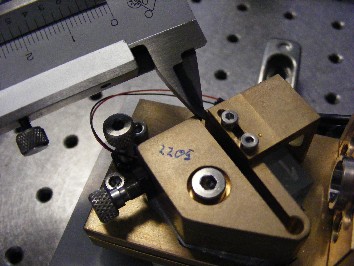
- It is helpful to fix the grating flexure at the current position by using, for example, a suitably chosen stack of washers or the like, such that they are clamped by the flexure (after slightly releasing the tuning screw).
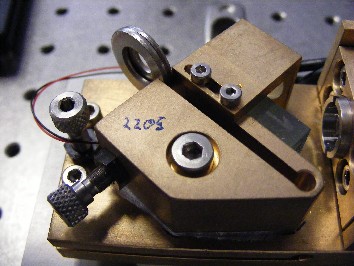
- Make sure that the tuning screw is released by a few turns, such that the load of the flexure is completely taken away from both the screw and the piezo. Next unscrew the black screw socket (see picture) and remove it together with the screw. Finally, remove the piezo carefully from the grating holder.
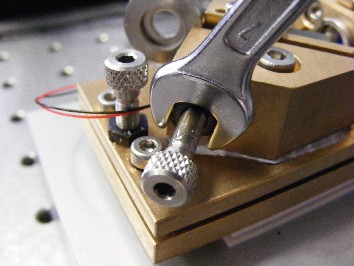
- This step is only necessary when replacing a piezo w/o cable connector (cp. step 6.). Loosen the BNC connector nut of the piezo cabling. To facilitate this, you might also want to remove the FET SMA connector as well. Now you can remove the old piezo and cabling by carefully pulling it through the BNC connector hole
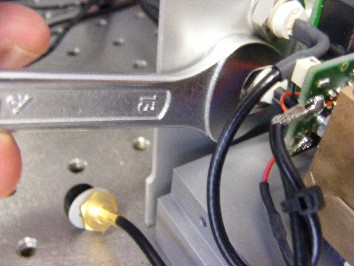
- Now that the old piezo is removed you are ready to install the new piezo. To do so, the same procedure has to be reversed as described in the following steps.It is recommended not to touch the piezo with bare hands. You can handle the piezo at the cable or with unpowdered gloves.
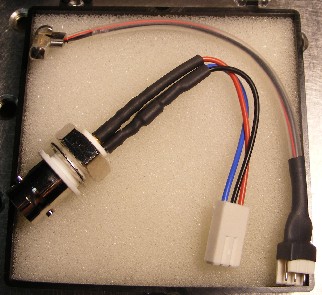
Unmounted piezo with cabling as provided by Toptica.
-
This step is only necessary once when replacing an old piezo. Remove the nut from the BNC connector and cable. Thread the cabling through the mounting hole. Put the nut back on and fix the BNC connector.
- Carefully insert the piezo into the grating holder with the cables guided thoroughly and freely through the grove until the piezo is just contacting the flexure. Make sure that the cables are well out of the way and cannot be damaged by the ball head of the tuning screw.
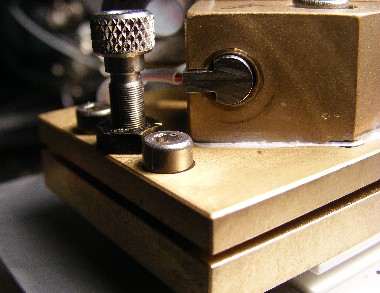 |
|
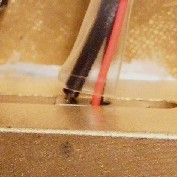 |
|
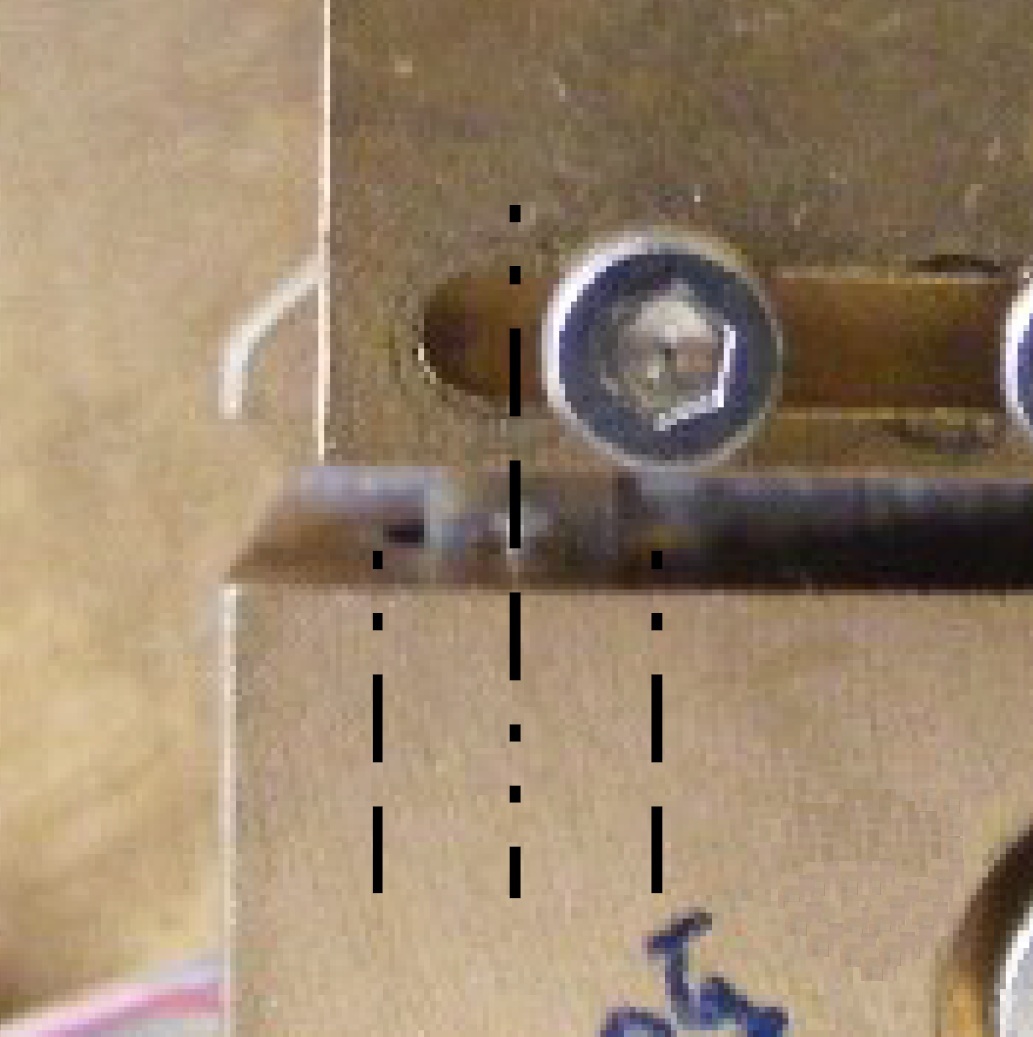 |
| |
Fig. A |
|
Fig. B |
| |
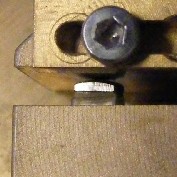 |
|
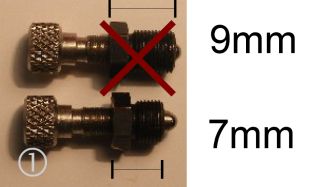 |
| |
Fig. C |
|
Fig. D |
When mounting the piezo please make sure that:
- the black screw socket has the same length (7mm) as the piezo (Fig. D). Otherwise exchange with the screw socket provided.
- The guiding nose of the end piece is properly aligned with the grating holder (Fig. A).
- the piezo is centered not touching the sides of the hole in the grating holder (Fig. B)and that the physical contact to the flexure is at the piezo tip (Fig. C). To verify proper mounting before applying high voltage check the resistance and capacitance (with cable) to be R >> 1MΩ (∞) and C≈235nF, respectively.
- First fix the black screw socket. Then tighten the tuning screw. Before the mechanical load is transferred to the tuning screw and piezo one should check that the piezo is centered with respect to its hole in the grating holder. You can, for example, use a ball driver to properly center the piezo tip horizontally.
- Once the mechanical load is transferred to the piezo, the washer(s) will be released. At that point the alignment is typically close enough to the original to see some feedback. If you do not see any feedback, rotate the tuning screw back and forth a bit first. For optimal performance you should readjust the feedback, i.e. minimize the threshold current.
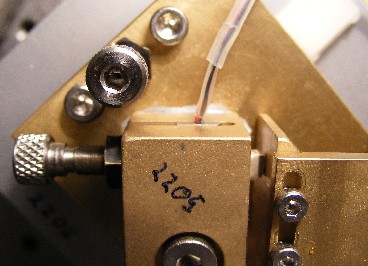
- Connect the piezo cable to the BNC connector cable.
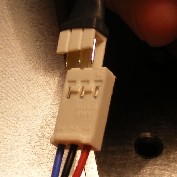
1.4. How to determine the polarity of the old style piezo?
The polarity of the PZT can be determined as follows:
- Connect both poles of the connector of the PZT to an oscilloscope (time base approx. 50ms/div, y-axis 200mV/div).
- Slightly tap the head of the PZT with your finger. As a result you should get a voltage pulse on the oscilloscope.
- Positive Amplitude -> + pole of the piezo is connected to the inner conductor of the oscilloscope BNC connector .
- Negative Amplitude -> + pole of the piezo is connected to the outer conductor of the oscilloscope BNC connector .
2. Service
2.1. Guide: locating feedback when no visible flashing occurs
This question predominantly arises for diodes with wavelengths greater than 1000nm where many cameras become insensitive and thus direct observation of the light is difficult. In this case we recommend the use of a power meter. In order to find a good starting point one can set the grating angle according to the wavelength, where the grating angle is defined between the collimator-/laser diode-holder (perpendicular to the beam) and the grating holder (front side on which the grating itself is mounted). In the table below the grating angle for selected wavelengths are given:
- 400 nm 46.8
- 630 nm 49.1°
- 670 nm 47,5°
- 780 nm 44,6°
- 795nm 45,7°
- 810 nm 46.8°
- 850 nm 49,9°
- 915 nm 43,3°
- 980 nm 47,3°
- 1010nm 49,3°
- 1060nm 47,9°
- 1300nm 40,5°
- 1350nm 42,4°
- 1600nm 46,1°
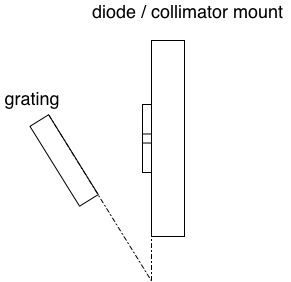
2.2. DL 100 Troubleshooting Guide
The DL 100 is user serviceable to a certain extent. In order to guide you towards locating and solving the most common problems we are making a troubleshooting workflow diagram available for download.
Before you start
These troubleshooting guides represent only a coarse outline of the steps necessary to get the laser system back to its specification. They do only complement, not replace the user manuals.
Before taking any of the following steps the user must familiarize himself with the hazards involved when mainting a laser source. READ AND FOLLOW THE SAFETY INSTRUCTIONS AND WARNINGS in the user manual carefully before you proceed. TOPTICA can not held be liable for injuries and / or damages caused by improper use of its lasers. If you feel unsure, please contact TOPTICA's service department first. Proceed at your own risk!PUBLIC/